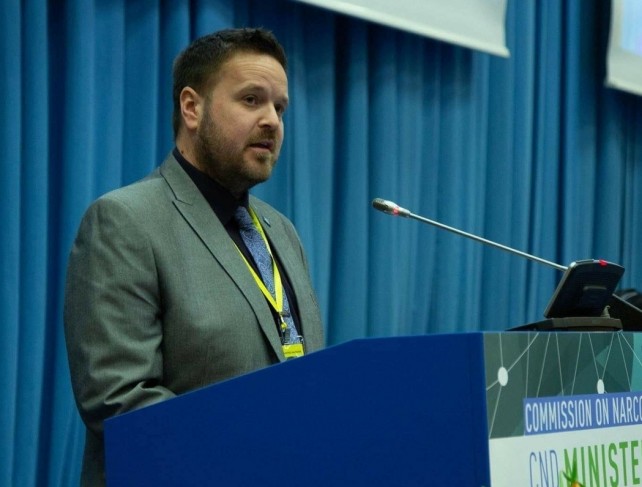TalkingDrugs’ Anastasia Bezverkha attended the European Harm Reduction Association (EHRA) conference in Prague and caught up with the International Drug Policy Consortium’s (IDPC) Chief Operating Officer Jamie Bridge on their latest drug policy tool: the Global Drug Policy Index (GDPI). The Global Drug Policy Index is available here.
Can you explain what are the 5 indicators you are using and the overall methodology behind the GDPI.
Jamie – First of all when we wanted to measure drug policies, we found a framework document – the United Nations Common Position on Drugs – to use as a minimum standard that every country should achieve. And when we looked at the UN reports, we came with 5 dimensions against which the drug policy can be measured.
The first one is “extreme responses” – this criterion gives country a more positive score if they don’t have death penalty or extrajudicial killings. But this is an extreme end of the war of drugs.
The second indicator is on proportionality – we look at the sentences the country uses and does the country has decriminalization in place. This criterion looks at the other elements of the country’s justice system.
The third one is “harm reduction”, which for us is obviously the key part of any drug policy.
The fourth one is a section on access to medicines and the reason for putting this out is that the UN drug control system is designed to ensure that people have access to controlled medicines and what we see around the world is the opposite. First of all, we talk about access to opioid painkillers. What we see is that countries focus so much on preventing access so they don’t make sure people have it available for medical purposes. There’s a global shortage of access to morphine and other painkillers, so we wanted to put an emphasis on this criterion.
The fifth dimension is “development” – and that is applied only to four countries in our list. We look at the countries which cultivate crops for drug production, the poppy or coca plants which are Afghanistan, Jamaica, Columbia and Thailand. In this dimension we look at alternative development programs implemented in these countries.
Can you tell us more about the countries from the Eastern Europe, which have been included in the GDPI. For instance, Georgia is number 7 overall in the ranking – that is a high score. But in the criterion of “proportionality” it’s only 25 (out of 100).
Jamie – Georgia shows, as do other European countries, that even though they came 7th in the list, what’s important is the overall score that they got. They only got 55 out of 100. We have found out from the Index that countries generally scored very badly – the average score is only 48.
Georgia’s score means that there’s a lot of work to be done. They did score highly when it comes to avoiding extreme responses (89 out of 100) because they don’t have death penalty, but on proportionality they got a very poor result. And this means that in this country there are prison sentences and punishments for drugs that are disproportionate and unjustified. And what we also look at is that these punishments disproportionately affect women, people of minority ethnic groups and other vulnerable populations.
In the GDPI we not only examine how the drugs policy looks like on paper, but also how it is implemented in real life. And that’s where Georgia scored particularly poorly.
Kyrgyzstan’s score is also quite high, but I believe it follows a similar logic. And they only got 39 in the “access to medicines” criterion.
Jamie – Kyrgyzstan scored lower than Georgia, they got 50 out of 100 points and they came 12th in the Index. But again, Kyrgyzstan is an example of a country where written policies tell us one thing, but real life experiences tell something very different: people are not receiving medicines that they need, either for pain relief or as an opioid substitution treatment or any other purpose.
This leads me to the next question about Russia – was it a political decision to include it in the ranking?
Jamie – The hardest thing we had to do with this Index is to choose 30 countries and the main reason for taking 30 but not all 192, was the limited resources we had available.
We wanted to have countries from all regions to be in our Index, we wanted countries with strong civil society movements, because we want people to use this data for their country’s advocacy efforts. We also included countries where there is data available and countries which have power and influence the region. And in all of those criteria, Russia is an important country. The result is that they came 20th in the list. But their score was only 41 out of 100 and this suggests that Russia needs urgent address. And please note that Russia has a much lower score than Georgia and Kyrgyzstan in avoiding extreme responses, because we have information about mandatory detention, extra-judicial detention and police brutality. All this is about Russia’s war on drugs approach. Russia has the lowest ranks in their region. Harm reduction is only 33 points, because the government still refuses to implement harm reduction approach to treating drug problem and officially opposing the use even of this term at the international level. There are some harm reduction services on the ground, but all of them are available because of civil society.
How did you collect the data for the Index? Did you use official data and how did you double-check it?
Jamie – The beauty of the GDPI is that is a composite index. It takes data from different sources, puts them into the methodology in order to create a score. We used the official data, the UN data, the government data, civil society data. We used desk research to look at the policies to answer questions like “does policy support harm reduction?” etc. We also used data from the “Global State of Harm Reduction” reports by Harm Reduction International. In addition, we conducted a survey in each of the country, where we asked the local experts, civic society and people who use drugs what is it like in their countries. And these data also impact on the score.
Next, we went through another process where all 75 indicators we came up with have been weighted all together to come up with the final 5 indicators. And obviously some of those many indicators have bigger impact on the final criterion, like for instance the death penalty.
How do you see the advocacy potential of the GDPI?
Jamie – Launching the GDPI is only the first stage of what we need to do. The reason that we’ve done the Index, is because we want this data to help local partners to do their advocacy. In each country they advocate for their own things: decriminalisation, pushing for needle and syringe exchange programs or abolishment of the death penalty. As we created the Index we worked with local partners in the countries, to provide them with an advocacy tool, to do at action in their countries. So, the aim is to translate Index into action. And having international media attention we hope to open some doors.
Do you expect this Index to change situation in countries like Russia?
Jamie – Yes, we have to be realistic, the Index on its own is not going to change the situation, but we have so many advocacy tools, and NGOs in Russia have been working so hard for decades to achieve some reforms. And the Index is definitely not a solution, but it is another effective tool. We all hope it will help our partners to attract more attention to the issue. If things do change, it won’t be because of the Index, but we hope the Index would have helped.
And if we keep pushing, things will change, even in the harshest places.
Do you plan to expand the Index in future?
Jamie – We have got 30 countries so you can say we now have a baseline. So now we need to keep repeating it every two years and see what’s changed. Obviously, we want to see all the countries moving up in their scores. Also, in two years we want the Index to grow from 30 to 40 countries.


